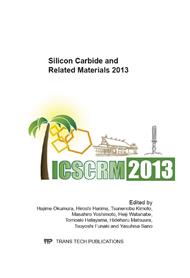p.657
p.661
p.665
p.669
p.673
p.677
p.681
p.685
p.689
Development of a Novel Cap-Free Activation Annealing Technique of 4H-SiC by Si-Vapor Ambient Annealing Using TaC/Ta Composite Materials
Abstract:
As a new post-implantation activation annealing of Silicon Carbide (SiC), we propose the Si-vapor ambient anneal using Tantalum Carbide / metal Tantalum composite materials (TaC/Ta). In this technique, semi-closed TaC/Ta container which can supply Si-vapor ambient is used, and Si vapor compensates thermal desorption Si atoms from the SiC surface above 1500°C and can maintain the original surface morphology by controlling a process temperature and Ar back pressure. Therefore the Si-vapor ambient anneal is able to simplify the process of conventional activation anneal methods using refractory cap-layers for protecting SiC surface from thermal damage of Si-atom desorption. Experiments were performed under Ar 1.3kPa at 1600/1700°C for 5min optimized conditions in a 6inch TaC/Ta container, and the Al+ ion-implanted 4H-SiC properties after annealing were characterized by atomic force microscopy (AFM), Rutherford Back-scattering Spectrometry (RBS) channeling method, and four-point probe method. According to evaluation, there was no roughening of SiC surface from AFM topographic images and recovery of crystallinity at the ion-implanted layer was equivalent to by the conventional cap-layer method from RBS channeling measurement. The sheet resistance of 12kΩ/ at 1700°C equal to the typical Al+ ion implanted p-type SiC is confirmed by four-point probe method.
Info:
Periodical:
Pages:
673-676
Citation:
Online since:
February 2014
Authors:
Keywords:
Price:
Сopyright:
© 2014 Trans Tech Publications Ltd. All Rights Reserved
Share:
Citation:


